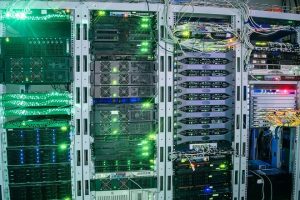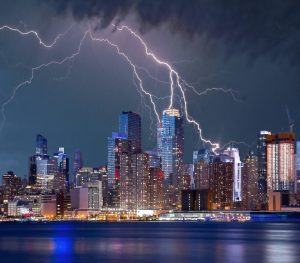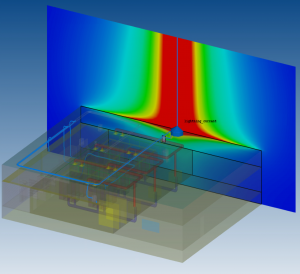
Lightning Strike
Lightning can be dramatic and beautiful, but we all know better than to head out onto the golf course during a storm. So, what is lightning and how can it affect digital systems?

Lightning occurs when an electrical charge builds up on water or ice particles within a storm cloud and the electric field becomes sufficiently high to cause the air to break down into electrons and positive ions[1]. This region of ionized air develops ‘stepped leaders’, a step-like series of charges that branch their way down towards the Earth. When a stepped leader gets close to the ground, an oppositely charged ‘streamer’ rises upward to meet it and a conducting channel is established between the cloud and ground. This discharges the cloud by enabling a pulse of current to flow and this is what we see as a flash of lightning. This ‘return stroke’ can reach peak levels of tens of thousands, or even hundreds of thousands of amps and is extremely hot (up to 30 000oC – 5 times hotter than the Sun!) which causes the surrounding air to rapidly expand, creating a shock wave that we hear as a thunderclap.
A building may provide a preferred path for lightning, particularly if it is tall and provides a low resistance channel due to metal in the structure, as metal is a good electrical conductor. The building will then become part of the lightning channel and be directly exposed to the intense return stroke current. The lightning current pulse contains sufficient energy to cause significant heating, potentially resulting in structural damage. High-intensity magnetic fields associated with the current[2] can induce harmful currents and voltages in cabling and electrical/electronic systems, causing the destruction of sensitive electronic components such as ICs or storage devices. Indirect lightning strikes nearby are also of concern, since the magnetic field could still be at a level sufficient to hurt critical infrastructure.
Electromagnetic Pulse (EMP)

Non-nuclear EMPs have been imagined in the plots of many action movies, with implications of damage to electrical and electronics systems, but how accurate is the idea that an EMP could wipe out the digital infrastructure of a building or even a city? EMP is a real phenomenon that can occur both naturally, or as a result of human activity. An example of a natural occurrence is a solar EMP, caused by a burst of plasma and its embedded magnetic field being ejected from the solar corona. An example of a man-made EMP is the pulse that occurs as a result of a nuclear explosion (NEMP) due to particles interacting with the earth’s atmosphere and magnetic field.
EMP generates high-intensity electromagnetic waves with peak electric field levels of tens of thousands of volts per meter. If these waves arrive at a building, they can enter by coupling through apertures such as windows, seams around doors, air vents, pipes, and via cabling. Once inside the building, EMP-generated fields couple to electronic systems and induce voltages and currents that can severely damage or burn out sensitive electronics and destroy stored data.
Protecting Digital Infrastructure
Lightning protection partly involves diverting current away from sensitive systems; for example, an air terminal or lightning rod may act as an interception point, collecting the lightning at a controlled location and conducting it to the ground safely.

Shielding is used to prevent low-frequency magnetic fields from diffusing through building materials and may also be applied to cabling. EMP protection generally involves ensuring that apertures are kept smaller than the wavelengths associated with EMP to reduce coupling/transmission, applying shielding to create protected zones (for example a data server hall). Conductive gaskets are installed in seams to effectively remove apertures, and conductive coatings can be applied to windows to attenuate field transmission through the glass material.
Filtering and transient protection devices may be used to attenuate or clamp the voltages and currents at connector interfaces. They can be applied at the point of entry (POE) where cable systems enter the building. Metallic mesh structures installed in utility pipes filter electromagnetic waves and prevent them from entering the building.
How Simulation Helps
Physics-based simulation enables lightning/EMP vulnerabilities in digital infrastructure design to be evaluated before the construction of a new building, or before upgrading an existing building, to harden against electromagnetic effects. Different protection schemes can be analyzed to assess their effectiveness. Parametric sweeps and optimizers are used to study design tradeoffs and avoid over-engineering, thereby reducing building material costs.
Multi-disciplinary, physics-based simulation can be used to ensure that design features implemented for electromagnetic protection do not hurt structural integrity or cooling system performance, or vice-versa. For example, metal piping or ducting deployed in the building, as part of the cooling system, could potentially act as a conduit for carrying electromagnetic fields and currents into the building and could even enhance the fields and worsen the damage, due to electromagnetic resonance effects.
Today’s modern simulation techniques using the Virtual Twin unlocks entirely new avenues for innovation by giving every engineer a full understanding of the entire system. Simulation with CST Studio Suite technology enables fields and coupling paths to be visualized, providing great insight into the electromagnetic performance of the building, leading to optimal design and protection. By accessing SIMULIA EM simulation technology through the 3DEXPERIENCE platform, all stakeholders work with up-to-date data for continuity from design to simulation to manufacturing.
References
[1] https://www.weather.gov/jetstream/lightning
[2] Ampère’s law
SIMULIA offers an advanced simulation product portfolio, including Abaqus, Isight, fe-safe, Tosca, Simpoe-Mold, SIMPACK, CST Studio Suite, XFlow, PowerFLOW, and more. The SIMULIA Community is the place to find the latest resources for SIMULIA software and to collaborate with other users. The key that unlocks the door of innovative thinking and knowledge building, the SIMULIA Community provides you with the tools you need to expand your knowledge, whenever and wherever.

